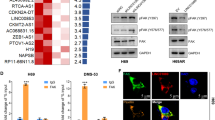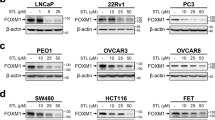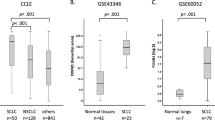Abstract
Non-small cell lung cancer (NSCLC) is an aggressive malignancy with a poor prognosis. Abnormal expression of focal adhesion kinase (FAK) is closely linked to NSCLC progression, highlighting the need for effective FAK inhibitors in NSCLC treatment. In this study we conducted high-throughput virtual screening combined with cellular assays to identify potential FAK inhibitors for NSCLC treatment. Fosaprepitant (FOS), a clinical antiemetic drug, exhibited a high affinity for FAK with a KD value of 4.35 × 10⁻⁵ M. The direct interaction between FOS and FAK was confirmed by molecular docking, molecular dynamics, drug affinity responsive target stability and surface plasmon resonance analysis. We showed that FOS (15, 25 μM) dose-dependently inhibited the proliferation, migration and invasion of A549 and H1299 cells by targeting FAK. The IC50 values in inhibiting the cell viability at 24 h were 73.05 and 126.1 μM, respectively. Knockdown FAK reversed the inhibitory effects of FOS on A549 cells. Using RNA sequencing and Western blotting analysis, we demonstrated that FOS treatment led to downregulation of the AKT and JNK/c-Jun signaling pathways in A549 and H1299 cells. Importantly, point mutation analyses revealed that FOS primarily targeted the Y925 phosphorylation site on FAK. In A549 cells xenograft nude mouse model, administration of FOS (20, 60 mg/kg, i.p. every 2 d for 2 weeks) dose-dependently suppressed the tumor growth. Collectively, FOS exhibits significant anti-NSCLC activity both in vitro and in vivo by binding to FAK and inhibiting its phosphorylation, thereby blocking the AKT and JNK/c-Jun signaling pathways. These results suggest FOS as a novel FAK inhibitor for NSCLC treatment.
This is a preview of subscription content, access via your institution
Access options
Subscribe to this journal
Receive 12 print issues and online access
$259.00 per year
only $21.58 per issue
Buy this article
- Purchase on SpringerLink
- Instant access to full article PDF
Prices may be subject to local taxes which are calculated during checkout









Similar content being viewed by others
References
Torre LA, Bray F, Siegel RL, Ferlay J, Lortet‐Tieulent J, Jemal A. Global cancer statistics, 2012. CA. 2015;65:87–108.
Ettinger DS, Wood DE, Aisner DL, Akerley W, Bauman JR, Bharat A, et al. NCCN guidelines® insights: non–small cell lung cancer, version 2.2023: featured updates to the NCCN guidelines. J Natl Compr Canc Netw. 2023;21:340–50.
Chan BA, Hughes BG. Targeted therapy for non-small cell lung cancer: current standards and the promise of the future. Transl Lung Cancer Res. 2015;4:36.
Herbst RS, Morgensztern D, Boshoff C. The biology and management of non-small cell lung cancer. Nature. 2018;553:446–54.
Yang M, Xiang H, Luo G. Targeting focal adhesion kinase (FAK) for cancer therapy: FAK inhibitors, FAK-based dual-target inhibitors and PROTAC degraders. Biochem Pharmacol. 2024;224:116246.
McLean GW, Carragher NO, Avizienyte E, Evans J, Brunton VG, Frame MC. The role of focal-adhesion kinase in cancer—a new therapeutic opportunity. Nat Rev Cancer. 2005;5:505–15.
Zhao J, Guan J. Signal transduction by focal adhesion kinase in cancer. Cancer Metastasis Rev. 2009;28:35–49.
Sulzmaier FJ, Jean C, Schlaepfer DD. FAK in cancer: mechanistic findings and clinical applications. Oncogene. 2014;14:598–610.
Mitra S, Lim S, Chi A, Schlaepfer D. Intrinsic focal adhesion kinase activity controls orthotopic breast carcinoma metastasis via the regulation of urokinase plasminogen activator expression in a syngeneic tumor model. Oncogene. 2006;25:4429–40.
Wozniak MA, Modzelewska K, Kwong L, Keely PJ. Focal adhesion regulation of cell behavior. Biochim Biophys Acta (BBA)-Mol Cell Res. 2004;1692:103–19.
Pan J, Zhang D, Zhang J, Qin P, Wang J. LncRNA RMRP silence curbs neonatal neuroblastoma progression by regulating microRNA-206/tachykinin-1 receptor axis via inactivating extracellular signal-regulated kinases. Cancer Biol Ther. 2019;20:653–65.
Lin H, Sun W, Zeng T, Li H, Xu C, Chen Y, et al. Identification of fosaprepitant as a novel GSTP1 inhibitor through structure-based virtual screening, molecular dynamics simulation, and biological evaluation. N J Chem. 2022;46:1042–53.
Scott KL, Nogueira C, Heffernan TP, Van Doorn R, Dhakal S, Hanna JA, et al. Proinvasion metastasis drivers in early-stage melanoma are oncogenes. Cancer Cell. 2011;20:92–103.
Mehta RR, Yamada T, Taylor BN, Christov K, King ML, Majumdar D, et al. A cell penetrating peptide derived from azurin inhibits angiogenesis and tumor growth by inhibiting phosphorylation of VEGFR-2, FAK and Akt. Angiogenesis. 2011;14:355–69.
Vara JÁF, Casado E, de Castro J, Cejas P, Belda-Iniesta C, González-Barón M. PI3K/Akt signalling pathway and cancer. Cancer Treat Rev. 2004;30:193–204.
Kwon GT, Cho HJ, Chung W-Y, Park KK, Moon A, Park JHY. Isoliquiritigenin inhibits migration and invasion of prostate cancer cells: possible mediation by decreased JNK/AP-1 signaling. J Nutr Biochem. 2009;20:663–76.
Pan Q, Wang Q, Zhao T, Zhao X, Liang Y, Shi M, et al. FAK inhibitor PF-562271 inhibits the migration and proliferation of high-grade serous ovarian cancer cells through FAK and FAK mediated cell cycle arrest. Med Oncol. 2023;40:215.
Aboubakar Nana F, Lecocq M, Ladjemi MZ, Detry B, Dupasquier S, Feron O, et al. Therapeutic potential of focal adhesion kinase inhibition in small cell lung cancer. Mol Cancer Ther. 2019;18:17–27.
Eom JW, Lim JW, Kim H. Lutein induces reactive oxygen species-mediated apoptosis in gastric cancer AGS cells via NADPH oxidase activation. Molecules. 2023;28:1178.
Wang B, Qi X, Li D, Feng M, Meng X, Fu S. Expression of pY397 FAK promotes the development of non‑small cell lung cancer. Oncol Lett. 2016;11:979–83.
Yu JS, Cui W. Proliferation, survival and metabolism: the role of PI3K/AKT/mTOR signalling in pluripotency and cell fate determination. Development. 2016;143:3050–60.
Balsas P, Palomero J, Eguileor Á, Rodríguez ML, Vegliante MC, Planas-Rigol E, et al. SOX11 promotes tumor protective microenvironment interactions through CXCR4 and FAK regulation in mantle cell lymphoma. Blood. 2017;130:501–13.
Dong C, Li X, Yang J, Yuan D, Zhou Y, Zhang Y, et al. PPFIBP1 induces glioma cell migration and invasion through FAK/Src/JNK signaling pathway. Cell Death Dis. 2021;12:827.
Hu HH, Wang SQ, Shang HL, Lv HF, Chen BB, Gao SG, et al. Roles and inhibitors of FAK in cancer: current advances and future directions. Front Pharmacol. 2024;15:1274209.
Mustafa M, Abd El-Hafeez AA, Abdelhafeez DA, Abdelhamid D, Mostafa YA, Ghosh P, et al. FAK inhibitors as promising anticancer targets: present and future directions. Future Med Chem. 2021;13:1559–90.
Spallarossa A, Tasso B, Russo E, Villa C, Brullo C. The development of FAK inhibitors: a five-year update. Int J Mol Sci. 2022;23:6381.
Wu X, Wang J, Liang Q, Tong R, Huang J, Yang X, et al. Recent progress on FAK inhibitors with dual targeting capabilities for cancer treatment. Biomed Pharmacother. 2022;151:113116.
Gerber DE, Camidge DR, Morgensztern D, Cetnar J, Kelly RJ, Ramalingam SS, et al. Phase 2 study of the focal adhesion kinase inhibitor defactinib (VS-6063) in previously treated advanced KRAS mutant non-small cell lung cancer. Lung Cancer. 2020;139:60–7.
Liu X, Wang Y, Shao P, Chen Y, Yang C, Wang J, et al. Sargentodoxa cuneata and Patrinia villosa extract inhibits LPS-induced inflammation by shifting macrophages polarization through FAK/PI3K/Akt pathway regulation and glucose metabolism reprogramming. J Ethnopharmacol. 2024;318:116855.
Brami‐Cherrier K, Gervasi N, Arsenieva D, Walkiewicz K, Boutterin MC, Ortega A, et al. FAK dimerization controls its kinase‐dependent functions at focal adhesions. EMBO J. 2014;33:356–70.
Horikiri Y, Shimo T, Kurio N, Okui T, Matsumoto K, Iwamoto M, et al. Sonic hedgehog regulates osteoblast function by focal adhesion kinase signaling in the process of fracture healing. PLoS One. 2013;8:e76785.
Harb LH, Arooj M, Vrielink A, Mancera RL. Computational site‐directed mutagenesis studies of the role of the hydrophobic triad on substrate binding in cholesterol oxidase. Proteins Struct Funct Bioinforma. 2017;85:1645–55.
Acknowledgements
This work was supported by grants from the 6th “ 333 High-level Talents Training Project ” of Jiangsu Province (Grant No. 2022-3-25-162), the Jiangsu Provincial Medical Key Discipline (Grant No. ZDXK202201), Original Exploration program for Suzhou Basic Research (Grant No. SSD2024036), the Scientific Research Project of Jiangsu Provincial Health Commission (Grant No. H2023115), and Suzhou Medical College-QiLu Medical Research Program of Soochow University (Grant No. 24QL200104).
Author information
Authors and Affiliations
Contributions
YW and YNS edited the manuscript; CKM, CYS, and YHZ processed the data; DL, HLZ; JJZ, YYZ, and JJL supervised; ZWY and ZYL provided funding.
Corresponding authors
Ethics declarations
Competing interests
The authors declare no competing interests.
Additional information
Publisher’s note Springer Nature remains neutral with regard to jurisdictional claims in published maps and institutional affiliations.
Supplementary information
Rights and permissions
Springer Nature or its licensor (e.g. a society or other partner) holds exclusive rights to this article under a publishing agreement with the author(s) or other rightsholder(s); author self-archiving of the accepted manuscript version of this article is solely governed by the terms of such publishing agreement and applicable law.
About this article
Cite this article
Wang, Y., Shao, Yn., Ma, Ck. et al. Antiemetic drug fosaprepitant exerts anti-tumor effects against NSCLC by targeting FAK to inhibit AKT and JNK/c-Jun pathways. Acta Pharmacol Sin (2025). https://doi.org/10.1038/s41401-025-01645-0
Received:
Accepted:
Published:
DOI: https://doi.org/10.1038/s41401-025-01645-0



